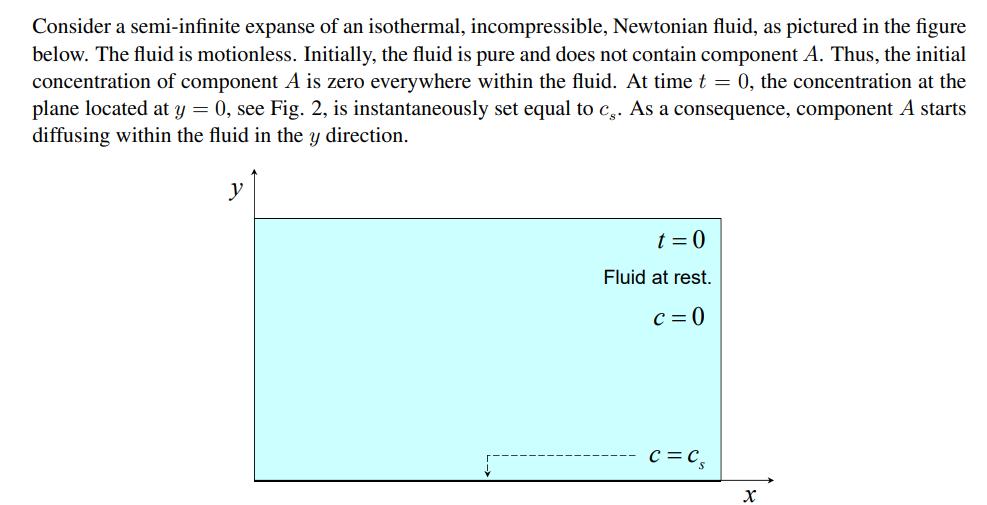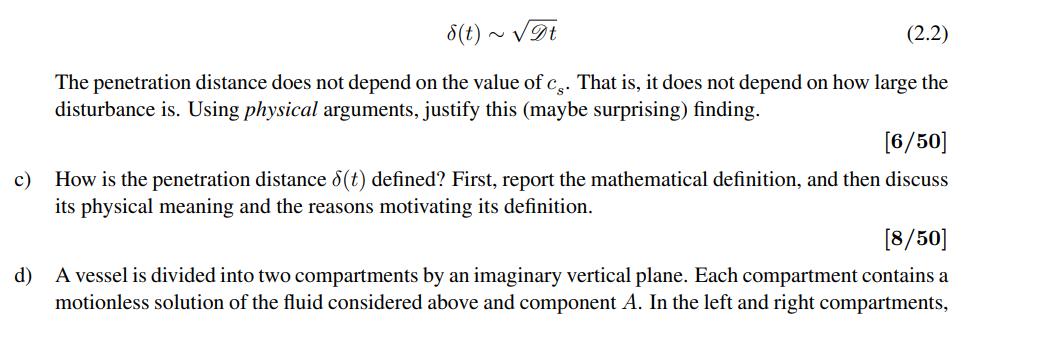Answered step by step
Verified Expert Solution
Question
1 Approved Answer
Consider a semi-infinite expanse of an isothermal, incompressible, Newtonian fluid, as pictured in the figure below. The fluid is motionless. Initially, the fluid is




Consider a semi-infinite expanse of an isothermal, incompressible, Newtonian fluid, as pictured in the figure below. The fluid is motionless. Initially, the fluid is pure and does not contain component A. Thus, the initial concentration of component A is zero everywhere within the fluid. At time t = 0, the concentration at the plane located at y = 0, see Fig. 2, is instantaneously set equal to c.. As a consequence, component A starts diffusing within the fluid in the y direction. y t=0 Fluid at rest. c=0 C = CS 18 X Figure 2: Sketch of the system. The z axis is normal to the sheet of paper. Assume that the fluid remains motionless during the mass transfer process, i.e., no convection is present and the mass transfer is only by diffusion. Assume also that the concentration of component A, denoted by c, is a function of the time t and of the coordinate y only, that is, c = c(y, t). Answer all the questions below in the reported order. a) After selecting an appropriate control volume, derive the mass balance equation governing the evolution of c(y, t). Prove that this reads: d+c = Dayc (2.1) where is the mass diffusivity of A in the fluid. To answer this question, do not employ the general mass balance equation for a component of a mixture. As said above, you must derive the mass balance equation yourself. [10/50] b) The disturbance imposed at the wall does not spread through the fluid instantaneously; after a time t, the disturbance has only penetrated a distance 8(t). By applying the scaling method to Eq. 2.1, estimate the function 8(t) and prove that: 8(t) ~ Dt (2.2) The penetration distance does not depend on the value of c.. That is, it does not depend on how large the disturbance is. Using physical arguments, justify this (maybe surprising) finding. [6/50] c) How is the penetration distance 8(t) defined? First, report the mathematical definition, and then discuss its physical meaning and the reasons motivating its definition. [8/50] d) A vessel is divided into two compartments by an imaginary vertical plane. Each compartment contains a motionless solution of the fluid considered above and component A. In the left and right compartments, e) c is uniform in space and equal to c and c, respectively. At time t = 0, the vertical partition is removed. Derive an expression for the initial concentration value c, at the plane of contact between the mixtures. Do you find the result surprising? Can you justify it with simple physical considerations? [20/50] Consider again the system described in part d). Estimate how long component A takes to diffuse over a distance L in each of the two compartments. To answer, use these data: C = 1 mol/m ; C = (1 + X) mol/m ; where X is the fourth (nonzero) digit of your student number. L = 10 cm ; m 9 10-10 r 2/s (2.3) [6/50]
Step by Step Solution
There are 3 Steps involved in it
Step: 1

Get Instant Access to Expert-Tailored Solutions
See step-by-step solutions with expert insights and AI powered tools for academic success
Step: 2

Step: 3

Ace Your Homework with AI
Get the answers you need in no time with our AI-driven, step-by-step assistance
Get Started


